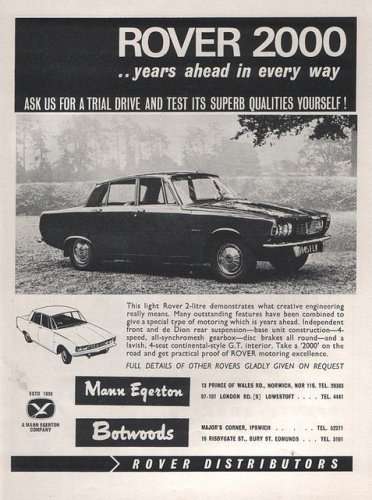Wednesday 9th October 1963
The Rover company, previously manufacturers of staid and technically unadventurous cars, announced the advanced P6 2000.
The vehicle was marketed first as the Rover 2000 and was a complete “clean sheet” design intended to appeal to a larger number of buyers than earlier models such as the P4 it replaced. Rover had identified a developing market between the standard ‘1.5-litre’ saloon car class (such as the Ford Consul and the Singer Gazelle) and the accepted ‘three-litre’ large saloon cars (typified by the Wolseley 6/99 and the Vauxhall Cresta). Younger and increasingly affluent professional workers and executives were seeking out cars that were superior to the normal 1.5-litre models in style, design and luxury but which offered more modern driving dynamics than the big three-litre class and lower purchase and running costs than sports saloons such as the Jaguar Mark 2. Automotive technology had improved significantly in the mid-to-late 1950s, typified by the introduction of cars such as the Citroen DS and Lancia Flavia in Europe and the Chevrolet Corvair in America. The replacement for the traditionally-designed P4 would therefore be a smaller car with a two-litre engine (although a gas turbine was invisioned as power unit in the future) utilising the latest design, engineering and styling, thus making the Rover one of the earliest examples of what would now be classified as an executive car. The P6 would be lower-priced than the P4 and sales volumes were anticipated to be significantly higher. The P5 was sold alongside the P6 until 1973.[citation needed]
The 2000 was advanced for the time with a de Dion tube suspension at the rear, four-wheel disc brakes (inboard on the rear), and a fully synchromesh transmission. The unibody design featured non-stressed panels bolted to a unit frame, inspired by the Citroën DS. The de Dion set-up was unique in that the “tube” was in two parts that could telescope, thereby avoiding the need for sliding splines in the drive shafts, with consequent stiction under drive or braking torque, while still keeping the wheels vertical and parallel in relation to the body.
The Rover 2000 won industry awards for safety when it was introduced and included a carefully designed “safety” interior. One innovative feature was the prism of glass on the top of the front side lights. This allowed the driver to see the front corner of the car in low light conditions, and also confirmed that they were operative.
One unique feature of the Rover 2000 was the design of the front suspension system, in which a bell crank (an L-shaped rotating bracket trailing the upper hub carrier joint) conveyed the vertical motion of the wheel to a fore-and-aft-horizontally mounted spring fastened to the rear wall of the engine compartment. A single hydraulically damped arm was mounted on the firewall for the steering.The front suspension was designed to allow as much width for the engine compartment as possible so that Rover’s Gas Turbine engine could be fitted. In the event, the engine was never used for the production vehicle, but the engine compartment width facilitated the accommodation of the V8 engine adopted years after the P6’s initial launch.
Sculptor Flaminio Bertoni’s Citroën DS body inspired David Bache. With a nod to the new Kamm tail, the finished Rover appearance incorporated a necessarily enlarged boot filled otherwise by Rover’s de Dion rear suspension. It lacked the Citroën shark nose, which it was planned to introduce later as a drooping bonnet with headlamps in pods and projecting sidelights.
The luggage compartment was limited in terms of usable space, because of the “base unit” construction, complex rear suspension and, in series II vehicles, the battery location. Lack of luggage space led to the optional mounting on the boot lid and also to optional Dunlop Denovo run-flat technology for a limited time on later vehicles.
The car’s primary competitor on the domestic UK market was the Triumph 2000, also released in October 1963, just one week after the Rover. In continental Europe the Rover 2000 contended in the same sector as the Citroën DS which, like the initial Rover offering, was offered only with a four-cylinder engine – a situation which was resolved in the Rover four years after its launch, when Rover’s compact V8 was engineered to fit into the engine bay. The Rover 2000 interior was not as spacious as those of its Triumph and Citroën rivals, especially in the back, where its sculpted two-person rear seat implied that Rover customers wishing to accommodate three in the back of a Rover should opt for the larger and older Rover 3 Litre.
Six days later Standard-Triumph announced the Triumph 2000.






